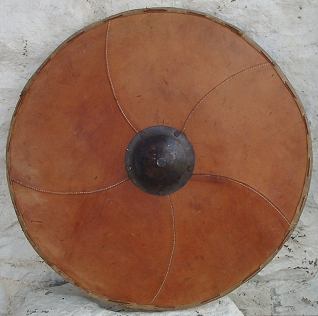
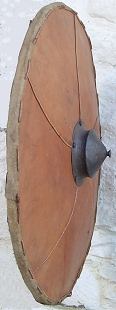
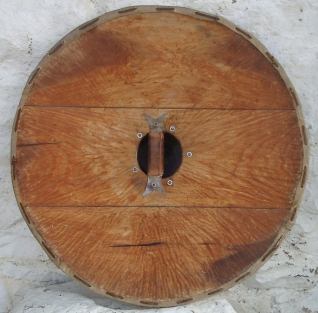

The main source of evidence for Anglo-Saxon shields comes from excavations of the iron fittings of the shield in furnished graves. Unfortunately, the perishable nature of the shield board leaves a number of gaps in our knowledge. Grave evidence from England is supplemented by a limited number of continental finds of complete shields and by representations in manuscript illustrations, sculpture and on metalwork.
Areas of debate include: how large were shields, how were they constructed, were they flat, curved in one dimension only or convex (lentoid) and how were the planks that make up the shield-board held together.
The most recent publications on Anglo-Saxon shields are Dickinson and Härke (1992) and Stephenson (2002). Dickinson and Härke consider convex shield boards to be unusual in the early Anglo-Saxon period and to have been shaped by softening the wood with steam or hot oil. Stephenson argues against convex boards, but proposes curvature in one plane as a by-product of gluing the planks together. Both consider at length the method by which the planks were held together, in the absence of evidence of metal nails or clips. Options discussed include dowels, rebating or cross-pieces/batons. None of these, however, appear satisfactory, being either at odds with the available evidence or impractical as a robust method of construction.
Academic interest has naturally focused on the iron boss and other fittings that survive, so that developments in the form of the boss have been seen as more significant than they would have been if complete shields had survived. Thus, Dickinson and Härke infer a transition from individual combat to fighting in formation in the sixth century on the basis of changes in the shape of the boss and the thickness and shape of the board. Reconstruction demonstrates that the size of the board is the most significant factor in determining for what style of combat it was developed rather than boss shape, larger shields being more suited to fighting in formation and against archery. Great care, however, should be taken in developing any theories of the nature of warfare on the basis of studies of weapons. Rather, greater significance should be placed on understanding the social and economic context, since factors such as the aims of the combatants and the size of forces employed are likely to have a greater influence on the nature of ancient warfare than modest changes in weapon technology. For a discussion of the nature of Anglo-Saxon warfare see Underwood (1999).
The reconstruction shield (fig. 1) is made of poplar, which, along with alder and willow, is one of the most common species identified from finds of shields (Dickinson and Härke, 1992). All three woods have a good balance of toughness to weight and a close grain that makes them resistant to splitting. It is made of 3 equal width planks with a total diameter of 72cm. The planks were glued together before the wood was shaped; the edges were simply butted together and joined using animal-bone glue. Planks 50mm thick were used and a convex board formed by hollowing out the centre and thinning the edges. The resulting board varies in thickness across the diameter between approximately 10-15mm, being thickest at the rim and thinnest near the centre. The entire thickness of the planks was used; hence, the front surface curves by 35mm over the radius. This is a relatively shallow curve, though still noticeable to the eye and sufficient to change the physical properties of the board. The shaping of the wood was undertaken using chisels and took approximately 40 hours; however, the time taken would probably reduce significantly with experience.
 |
 |
| Figure 1a: The reconstruction: Front View | Figure 1b: The reconstruction: Threequarters View |
 |
 |
| Figure 1c: The reconstruction: Back View | Figure 1b: The reconstruction: Side View |
The curvature of the board increases its strength without any increase in weight. In addition, the convex board formed is robust with the planks simply glued together and does not require the planks to be joined with dowels or rebates or to be reinforced with batons. This is because the glued joint curves along its length so that any torque applied to the joint is balanced by the compression of the wood at either end of the joint. If the planks were flat even modest torque would cause the glue to fracture.
This method of manufacture is consistent with the method of processing of timber in the Anglo-Saxon period, which was undertaken without significant use of saws. Planks would be formed by splitting a tree either once into half-rounds or several times radially to form segments and then reducing the excess to form planks using axes (Goodburn, 2001). In either case, thin planks could only be formed by reducing thicker planks. Forming curved planks is therefore little more effort than making flat planks if the planks have to be thin.
The board is covered with leather. The curvature of the board requires the leather to be cut into panels. Five panels were used, each a curved sided triangle. They were laid on the board so that they overlapped, marked up, cut to size and then stitched together using linen thread. The resulting cover fitted the board easily and was attached using animal glue. The edge of the cover was secured, and the rim of the shield strengthened with a rawhide rim. The rawhide was soaked to make it flexible and secured by stitching to the board through pre-drilled holes using a leather thong.
The covering using leather panels is consistent with the predominant form of decoration of shields in representations of the period in England and on the continent, i.e. a number of lines curving out from the boss in a broad spiral. Examples include a tenth or eleventh century manuscript illustration of two swordsmen engaged in single combat (MS Cotton Cleopatra C VIII) (fig 2), the eighth or ninth century Trier Apokalypse (Cod. 31, f.63, Stadtbibliothek, Trier), the early eleventh century illustration of the 'Vision of Habukuk' in the Bible de St Vaast (MS 435, Bibliothèque Municipale, Arras) and carvings of horsemen on the Gotland picture stones and the seventh century stone slab from Hornhausen (fig 3). That the pattern derives from the leather covering of the board is most clearly illustrated in a detail from the ninth-century Stuttgart Psalter (fig. 4). Indeed, the ubiquity of this pattern in examples from across Europe and spanning over five hundred years would be surprising were it not related to the method of construction.
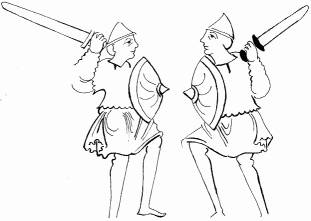 |
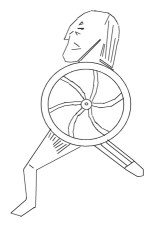 |
| Figure 2: MS Cotton Cleopatra C VIII | Figure 3: Stone slab from Hornhausen |
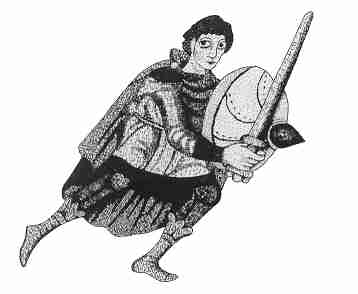 |
|
| Figure 4: Stuttgart Psalter | |
Shields are frequently depicted with rims in illustrations and carvings; finds, however, are rare suggesting perishable materials may have been used. The copper alloy shield rim from Sutton Hoo is pierced, suggesting it was sewn to the board and surviving shield boards from both Viking and Roman contexts have holes around the edge suggesting a perishable rim sewn to the board (Stephenson, 2002).
The shield was finished by attaching a short iron flanged grip enclosing a wooden handle and an iron carinated boss. The complete shield weighs 4kg, in line with Dickinson and Härke's estimates of 3-5kg.
Reconstruction of an archaeological find can be a valuable method of gaining understanding of its form, manufacture and use. Practical constraints cannot be glossed over, and the significance of evidence that may have been ignored can be recognised. Above all, reconstruction consolidates academic knowledge into practical understanding.
The value is significantly enhanced if the reconstruction is undertaken using the tools available in the period, either copies or modern versions with similar properties, and by starting with base materials and undertaking all stages of the manufacture.
A reconstruction of an Anglo-Saxon shield demonstrates the value of this approach as an aid to understanding:
Dickinson T. and Härke H. 1992. Early Anglo-Saxon Shields, Archaeologia, 110
Goodburn, D. 2001. pers com.
Stephenson, I.P. 2002. The Anglo-Saxon Shield, Stroud
Underwood, R. 1999. Anglo-Saxon Weapons & Warfare, Stroud